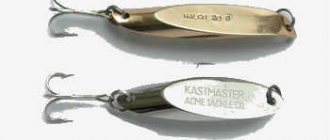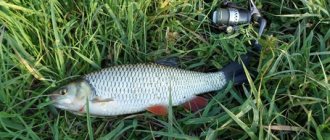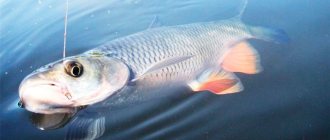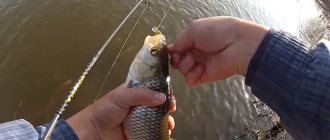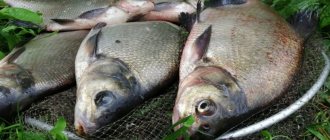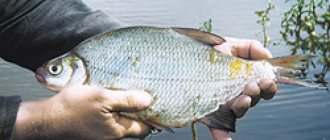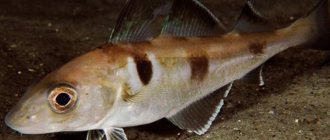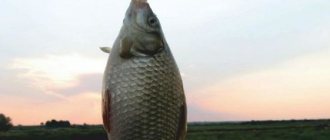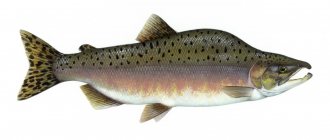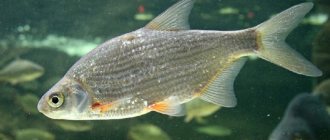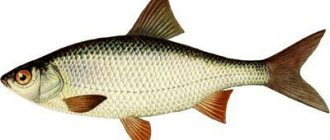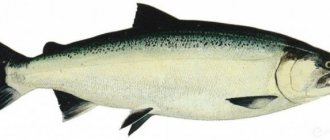Yuri 03.11.2020 454
Despite the fact that fishermen do not particularly favor them, asp and chub still arouse some interest among a certain category of hunters. Nature has awarded the fish with a similar appearance, so it will be difficult for novice fishermen to distinguish these species from each other. To finally understand how an asp differs from a chub, we suggest that you familiarize yourself with a detailed description of each representative of the ichthyofauna.
Ide
Ide is a fish of the carp family. The average size of the fish is from 30 to 50 cm and weighs 0.6-2 kg. Trophy sizes grow up to 1 m and weigh 5-7 kg. Large individuals live separately, gathering in flocks for the winter and during the spawning period.
But small individuals lead a gregarious lifestyle. The ide has a very beautiful color, silver with a gray tint, with a golden sheen from the gill slits to the end of the head. The back is dark blue, the sides have a white tint. The belly is bright silver. Fins with a reddish tint. The older the individual, the more intense the color the fish acquires.
Expert opinion
Valery Andreevich Sizov
Professional fisherman with 35 years of experience
Life expectancy is 10-15 years, trophy individuals live up to 20 years.
The ide is a very hardy fish, it easily tolerates resonances in temperature, so it feeds even in winter. It prefers slow currents and deep places, near the shore in the shade of overhanging trees or closer to pools and bridges. At the same time, it tolerates low salinity of water well, so it can live in river deltas The ide is euryphagous and can feed on both fry and plant foods .
In the spring, after wintering, in order to replenish lost weight and energy, it feeds exclusively on animal foods, and in the summer and autumn it switches to plant foods.
In the diet:
- worms;
- shellfish;
- insects;
- larvae of caddisflies, stoneflies;
- fish fry.
How to choose a wobbler for asp
The choice of bait depends on many factors - the fishing season, buoyancy and shape, which determine whether the fish will be interested in food. Luring an asp using a wobbler is not an easy task and requires skill and patience.
Manufacturers offer different types of gear for catching and landing predators, but not all fishermen know what characteristics they should pay attention to first.
What experienced spinning anglers note when choosing the best wobbler for asp:
- Casting range. The predator is very careful and does not take the bait if the fisherman is somewhere nearby. When fishing, you need to cast as accurately as possible and with a good range.
- Shape and size. The optimal ratio is a wobbler 5-7 cm in length with a realistic look.
- Buoyancy. Fishermen do not have a definite solution; a sinking bait allows you to fish in different layers of water and has a longer cast. A floating wobbler makes it possible to deliver it downstream to the right place.
- A game. The asp is attracted to the trembling type of movement; sharp jerks are more likely to scare away the predator and leave the fisherman without a catch.
- The color should be similar to the prey: dark back, bright silver belly and characteristic stripes.
Tips for fisherman: Spinning bait for asp in summer - Features of choice
These are the main characteristics of a wobbler that need to be taken into account when catching asp. But there are also seasonal subtleties in choosing gear to return home with prey.
- In the spring, small models of 30-40 mm with the natural color of asp prey are chosen. Fishing is preferable with shallow depth and active play.
- In summer, a wobbler of 45-70 mm in size with an active game of brown, green and golden color and a depth of 1.5-2 m.
- In autumn, the largest models up to 90 mm in brown, red and black are chosen. The action of the bait is calm and sluggish with stable performance in the current.
- In winter, it is better to use a 50 mm wobbler with active play in a bright red color with stripes.
Chub
Chub
The chub also belongs to the carp family. It can reach more than 50 cm in length and weigh up to 8 kg. It is often confused with ide, but the main difference between them is the shape of the head.
The chub has a large mouth, teeth arranged in two rows, powerful jaws. Like many cyprinids, they have pharyngeal teeth. Thanks to its large mouth and teeth located in the throat, the chub easily copes with the hard chitinous coverings of crustaceans. The body is cylindrical, elongated and slightly compressed from the sides, which allows it to feel good in the current.
The back is dark, the body itself - the sides and belly are light. The scales are quite large and thick. The fins near the head are almost orange in color, while those on the belly are red. With age, the pectoral fins and tail change color to a darker one. Chub are sensitive to water purity, oxygen saturation and acidity. It lives in rivers with fairly fast currents or in flowing lakes with a hard bottom. It prefers to hunt from ambush, while hiding from other predators and birds .
In addition to small fish, the diet also includes various insects (flies, mosquitoes, butterflies, beetles, etc.), eggs of other fish, worms, larvae and caterpillars, and filamentous algae. In small individuals, vegetation and insects predominate in the diet, which is why they grow longer, while adults almost completely switch to small fish.
About useful and culinary properties
Ide is a very nutritious and tasty fish , however, due to its high calorie content, caution should be exercised when consuming it, especially for people with weight problems. Nutritional value is:
- Calorie content (fresh ide) - 116 kcal.
- Calorie content (boiled ide) - 88 kcal.
- Proteins – 19 g per 100 g of fish.
- Fats – 4.5 g.
- Carbohydrates – 75 gr.
Protein contains amino acids essential for human health: taurine, lysine, tryptophan.
Ide meat is a real storehouse of microelements useful for the human body: it also contains phosphorus, calcium, magnesium, potassium, iron, chromium, molybdenum, sodium. Dishes made from this fish are perfectly absorbed by the body. Due to the high content of phosphorus and calcium, ide can be an excellent means of preventing osteoporosis and other diseases of bones and teeth. Ide is a very beautiful and useful fish, catching which is a blessing for any fisherman.
It has a wide distribution area and important commercial value, which is why the fish often becomes an object of fishing at the amateur level.
Asp
Asp is another representative of the carp family. It has a massive, shortened and at the same time thick body, with large silvery scales.
The carcass has an uneven grayish color. The back is dark with a gray-blue tint, the sides are silver-blue, and the belly is white. The fins, front and bottom, with a gray tint at the tips, become darker. The dorsal fin is sharp, long and thin. A very powerful tail, thanks to which it stuns its victims, the lower half is longer than the upper. An elongated head with a massive lower jaw and a large mouth.
There are no teeth, only pharyngeal teeth. Instead, there are jaw bumps and depressions, thanks to which it is able to strongly hold the victim. The asp prefers clean, oxygenated water. Inhabits medium-flow rivers, flowing lakes and ponds. Hunts mainly near the surface, on small fish . Small individuals live in schools and feed mainly on worms and bloodworms; by the age of two they become predators.
Expert opinion
Valery Andreevich Sizov
Professional fisherman with 35 years of experience
The asp grows very quickly and is considered one of the largest and most aggressive fish among cyprinids.
The average size of specimens is 2-2.5 kg. with a length of 60 cm, but trophy specimens reached 12 kg. weight and size just over a meter.
Tactics for catching asp
Cautious fish require attention: equipment, a supply of rigs, knowledge of the reservoir and the characteristics of the intended catch. Thus, fishing tactics are developed that should be followed during fishing, making minor adjustments. The best scheme is considered to be a constant change of promising points, this way a large area of water is covered, and active fish are found much faster.
It is worth observing the surface of the water. The characteristic splashes of the fry, scattering in different directions, indicate a hungry predator nearby. You can start fishing with a wolf for asp. The first cast is the most important, the bait should be cast as slowly as possible in the promising area. If there are no bites, it is worth changing the wiring options and artificial baits. The faster you can pick up the “key,” the richer the catch awaits you at the end of the day.
Tips for fisherman: Tackle for catching asp on a spinning rod - What to choose for fishing
The most promising asp parking spots:
- boundary of a jet with a slow flow;
- riffles with a sandy bottom;
- spits and coastal edges;
- shallow water in the middle of a reservoir with an abundance of fry;
- under cliffs with characteristic holes.
The technique is to animate the bait. An active fattening predator can be successfully caught with a twitch, a floating wobbler, a crankbait or a walker. But if the fish is passive, suspenders come to the fore, and the wiring looks like small swaying with smooth pull-ups.
According to experts and reviews from fishermen, the highest quality wobblers are produced by the following manufacturers:
A wobbler is considered one of the best baits for hunting chub and other fish. This is the product that experienced catch hunters trust. The best wobblers are noticeable in the water; they are selected depending on the time of year, type of fish, fishing conditions and, of course, the manufacturer. Belonging to a certain brand can tell a lot about a product.
According to experts and reviews from fishermen, the highest quality wobblers are produced by the following manufacturers:
All of the listed manufacturers of wobblers have proven themselves only on the positive side and have earned many good reviews.
Deep group. Wobblers for medium depth also do not have a blade. Going to depth is carried out by the curvature of the shape and the place where the tackle is attached to its body (rattlin, jerkbait, darter) .
Differences between ide, chub and asp
Even experienced fishermen are not always able to distinguish representatives of these fish. The thing is that they all belong to representatives of the carp family, therefore they have a lot of common external characteristics. At a young age, there are practically no even minor differences between them, so fishermen don’t even know what kind of fish they are and call them by the same name.
With age, some distinctive features begin to appear, so every fisherman must imagine how to distinguish these representatives of the carp family from each other, if only in order to know what kind of trophy he is showing off.
Expert opinion
Valery Andreevich Sizov
Professional fisherman with 35 years of experience
The chub got its name due to the shape of its head; it has a blunt shape, unlike other representatives.
In asp and ide it is narrower and more pointed. The back of the chub is darker than that of the ide, has a dark green color, the fins are bright red, while those of the ide are slightly reddish. The chub's mouth is larger and its scales are darker. In addition, it does not live in stagnant water, unlike its relatives. The main distinguishing feature of the asp from other representatives of cyprinids is the absence of teeth on the jaw. It is lighter silver than the chub . The anal fins are wide.
In addition, the sheresper has a distinctive jaw structure; the lower part is longer, so it protrudes forward. These signs will help you see the differences between fish. These signs are especially clearly visible if the catch contains representatives of several species of cyprinids at the same time.
And if you are interested in the habitats of the asp, you can check it out here.
How to distinguish ide from asp
Another representative of cyprinids, which is quite easily confused with the predators mentioned above, is the ide. There is no clear answer to the question of what is the main difference between ide and asp. Although, the relatively wide body, flattened head and small mouth noticeably distinguish the fish. A distinctive feature here is the rather large eyes (in the asp they are slightly smaller in relation to the size of the body).
We tried to generalize and at the same time find differences between three predators of the carp family. They all love currents and clean water. All are loved by fishermen for their resistance and because they are ready to decorate any table. However, an experienced eye can find many differences between them.
We hope that the information from this article was useful to you and added to your knowledge base. All that remains is to catch one of them and determine to whom exactly you owe the resulting drive and positive mood.
The asp or sheresper, the chub or smut, and the ide or roach belong to the same family - cyprinids. Nature has made them very similar to each other, so much so that an inexperienced fisherman cannot distinguish them. But no matter how similar they are, they have many differences. More on this below.
